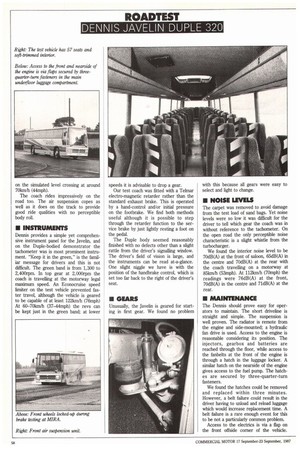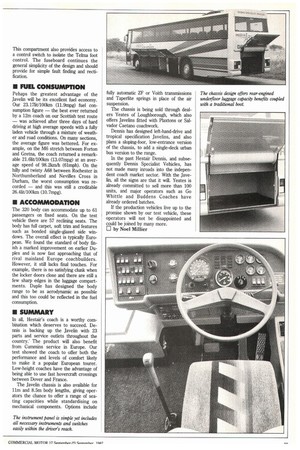LOW FLYING JAVELIN
Page 58

Page 59

Page 60

Page 61

If you've noticed an error in this article please click here to report it so we can fix it.
The Javelin-bodied Dennis offers the best fuel consumption of any 1 2-metre coach we have tested —yet combines this with a high average speed and lively acceleration.
• When Dennis Specialist Vehicles launched its Javelin coach chassis at last year's NEC Motor Show, many pundits predicted it would be an obvious candidate to fill the gap left by the untimely departure of Bedford from the market. Having tested one with a Duple 320 body, we can report that it offers far more than a mere alternative to the Bedford: it performs in a manner Likely to make it a challenger to heavier and more expensive chassis on the market.
On our 1,1631m test route it returned the best fuel consumption figure we have recorded for a 12m coach. It was heavily laden to represent a full passenger load with luggage and still managed a high average speed of 80.5km/h (50mph). In acceleration tests it was quicker than many vehicles, including a lighter-laden Van Hool powered by a 10-litre Cummins, tested earlier this year (CM 25 April).
The Javelin is equipped with the American-built Darlington-dressed Cummins C-series engine. The turbocharged and charge-cooled unit is rated at 179kW (240hp).
Our test vehicle, one of the first Javelins to be bodied, has the familiar and well-proven ZF S 6.80 gearbox.
Its soft-trimmed Duple 320 body is fitted with maximum luggage lockers and 57 Duple reclining seats.
The Javelin, according to Dennis, changes the economics of coach operation by giving "a hitherto unobtainable combination" of low weight and low initial cost with the high performance and long-life durability of the premium heavyweights, a claim our test results seem to back up. The welded frame arrangement, with its relatively long, 6,250mm wheelbase, allows the engine to be accommodated upright and forward of the rear axle. When bodied, the coach has a full traditional rear boot together with extensive underfloor lockers. The end result is a low-height coach with the 10m3-plus luggage space normally found only in much more expensive high-floor vehicles. There is far less redundant metal carried in the completed coach because of the construction of the stepped chassis frame.
In fact the designers claim their chassis is around 15% lighter than a typical conventional heavyweight chassis.
• RIDE AND HANDLING
On the road we found little to criticise and much to commend from the drivers' point of view. The remote control linkage to the 2F gearbox gives a very positive and easy gearchange. The air-assisted clutch is light and the brakes are progressive and predictable, although the front wheels did lock-up during emergency stop tests at the MIRA track near Nuneaton.
We found power steering offered by the ZE integral arrangement gave just the right degree of "feel".
Some road shocks are transmitted through to the steering wheel but the coach's handling is not seriously affected.
Around the ride and handling circuit at MIRA we found the Javelin surefooted, It took adverse cambers, potholes and level crossings in its stride and hardly bounced on the simulated level crossing at around 701on/h (44mph).
The coach rides impressively on the road too. The air suspension copes as well as it does on the track to provide good ride qualities with no perceptible body roll.
• INSTRUMENTS
Dennis provides a simple yet comprehensive instrument panel for the Javelin, and on the Duple-bodied demonstrator the tachometer was is most prominent instrument. "Keep it in the green," is the familiar message for drivers and this is not difficult. The green band is from 1,300 to 2,400rpm. In top gear at 2,000rpm the coach is travelling at the motorway legal maximum speed. An Econocruise speed limiter on the test vehicle prevented faster travel, although the vehicle is geared to be capable of at least 122km/h (76mph) At 60-70Ion/h (37-44mph) the revs can be kept just in the green band; at lower speeds it is advisable to drop a gear.
Our test coach was fitted with a Telmar electro-magnetic retarder rather than the standard exhaust brake. This is operated by a hand-control and/or initial pressure on the footbrake. We find both methods useful although it is possible to step through the retarder function to the service brake by just lightly resting a foot on the pedal.
The Duple body seemed reasonably finished with no defects other than a slight rattle from the driver's signalling window. The driver's field of vision is large, and the instruments can be read at-a-glance. One slight niggle we have is with the position of the handbrake control, which is set too far back to the right of the driver's seat.
• GEARS
Unusually, the Javelin is geared for starting in first gear. We found no problem with this because all gears were easy to select and light to change.
• NOISE LEVELS
The carpet was removed to avoid damage from the test load of sand bags. Yet noise levels were so low it was difficult for the driver to tell which gear the coach was in without reference to the tachometer. On the open road the only perceptible noise characteristic is a slight whistle from the turbocharger.
We found the interior noise level to be 70dB(A) at the front of saloon, 65dB(A) in the centre and 70dB(A) at the rear with the coach travelling on a motorway at 85km/h (53mph). At 112km/h (70mph) the readings were 76dB(A) at the front, 70dB(A) in the centre and 71dB(A) at the rear.
• MAUI/ITT-NANCE
The Dennis should prove easy for operators to maintain. The short driveline is straight and simple. The suspension is well proven. The radiator is remote from the engine and side-mounted; a hydraulic fan drive is used. Access to the engine is reasonable considering its position. The injectors, gearbox and batteries are reached through the floor, while access to the fimbelts at the front of the engine is through a hatch in the luggage locker. A similar hatch on the nearside of the engine gives access to the fuel pump. The hatches are secured by three-quarter-turn fasteners.
We found the hatches could be removed and replaced within three minutes. However, a belt failure could result in the driver having to unload and reload luggage which would increase replacement time. A belt failure is a rare enough event for this to be not a particularly common problem.
Access to the electrics is via a flap on the front offside corner of the vehicle. This compartment also provides access to a control switch to isolate the Telma foot control. The fuseboard continues the general simplicity of the design and should provide for simple fault finding and rectification.
• FUEL CONSUMPTION
Pehaps the greatest advantage of the Javelin will be its excellent fuel economy. Our 23.17k/100km (11.9mpg) fuel consumption figure — the best ever returned by a 12m coach on our Scottish test route — was achieved after three days of hard driving at high average speeds with a fully laden vehicle through a mixture of weather and road conditions. On many sections, the average figure was bettered. For example, on the M6 stretch between Forton and Gretna, the coach returned a remarkable 21.6lit/100km (13.07mpg) at an average speed of 98.2km/h (61mph). On the hilly and twisty A68 between Rochester in Northumberland and NeviIles Cross in Durham, the worst consumption was recorded — and this was still a creditable 26. 4lit/1001tin (10. 7mpg).
II ACCOMMODATION
The 320 body can accommodate up to 61 passengers on fixed seats. On the test vehicle there are 57 reclining seats. The body has full carpet, soft trim and features such as bonded single-glazed side windows. The overall effect is typically European. We found the standard of body finish a marked improvement on earlier Dupies and is now fast approaching that of rival mainland Europe coachbuilders. However, it still lacks final touches. For example, there is no satisfying clunk when the locker doors close and there are still a few sharp edges in the luggage compartments. Duple has designed the body range to be as aerodynamic as possible and this too could be reflected in the fuel consumption.
• SUMMARY
In all, Hestair's coach is a worthy combination which deserves to succeed. Dennis is backing up the Javelin with 23 parts and service outlets throughout the country. The product will also benefit from Cummins service in Europe. Our test showed the coach to offer both the performance and levels of comfort likely to make it a popular European tourer. Low-height coaches have the advantage of being able to use fast hovercraft crossings between Dover and France.
The Javelin chassis is also available for llm and 8.5m body lengths, giving operators the chance to offer a range of seating capacities while standardising on mechanical components. Options include fully automatic ZF or Voith transmissions and Taperlite springs in place of the air suspension.
The chassis is being sold through dealers Yeates of Loughborough, which also offers Javelins fitted with Plaxtons or Salvador Caetano coachwork.
Dennis has designed left-hand-drive and tropical specification Javelins, and also plans a sloping-foor, low-entrance version of the chassis, to add a single-deck urban bus version to the range.
In the past Hestair Dennis, and subsequently Dennis Specialist Vehicles, has not made many inroads into the independent coach market sector. With the Javelin, all the signs are that it will. Yeates is already committed to sell more than 100 units, and major operators such as Go Whittle and Buddens Coaches have already ordered batches.
If the production vehicles live up to the promise shown by our test vehicle, these operators will not be disappointed and could be joined by many more. D by Noel Millier




































































































